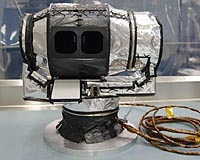 |
Greenbelt, Md. (UPI) Jun 24, 2009 The U.S. space agency says its Interstellar Boundary Explorer has made the first detection of very fast neutral atoms emanating from the moon. The discovery came during the spacecraft's commissioning, when scientists turned on the IBEX-Hi instrument, which measures atoms with speeds from about half a million to 2.5 million miles per hour. "Just after we got IBEX-Hi turned on, the moon happened to pass right through its field of view, and there they were," said David McComas, IBEX principal investigator. "The instrument lit up with a clear signal of the neutral atoms being detected as they backscattered from the moon." The discovery, NASA said, comes after decades of speculation and unsuccessful searching for such lunar neutral atoms. IBEX -- the latest in NASA's series of low-cost, rapidly developed spacecraft -- was built to primarily observe and map the complex interactions occurring at the edge of the solar system, NASA said the spacecraft carries the most sensitive neutral atom detectors ever flown in space, enabling researchers to not only measure particle energy, but also to make precise images of where they are coming from. The new findings appear in the journal Geophysical Research Letters. Share This Article With Planet Earth
Related Links Mars News and Information at MarsDaily.com Lunar Dreams and more
 Diviner is ready to start lunar mapping
Diviner is ready to start lunar mappingPasadena, Calif. (UPI) Jun 24, 2009 The U.S. space agency's Diviner, an instrument that will map the moon's temperature, has entered a lunar orbit aboard NASA's Lunar Reconnaissance Orbiter. The instrument, a nine-channel radiometer built and managed by NASA's Jet Propulsion Laboratory, will also, for the first time, produce a map showing the composition of the moon, as well as a map showing how rocky the moon is. ... read more |
|
| The content herein, unless otherwise known to be public domain, are Copyright 1995-2009 - SpaceDaily. AFP and UPI Wire Stories are copyright Agence France-Presse and United Press International. ESA Portal Reports are copyright European Space Agency. All NASA sourced material is public domain. Additional copyrights may apply in whole or part to other bona fide parties. Advertising does not imply endorsement,agreement or approval of any opinions, statements or information provided by SpaceDaily on any Web page published or hosted by SpaceDaily. Privacy Statement |